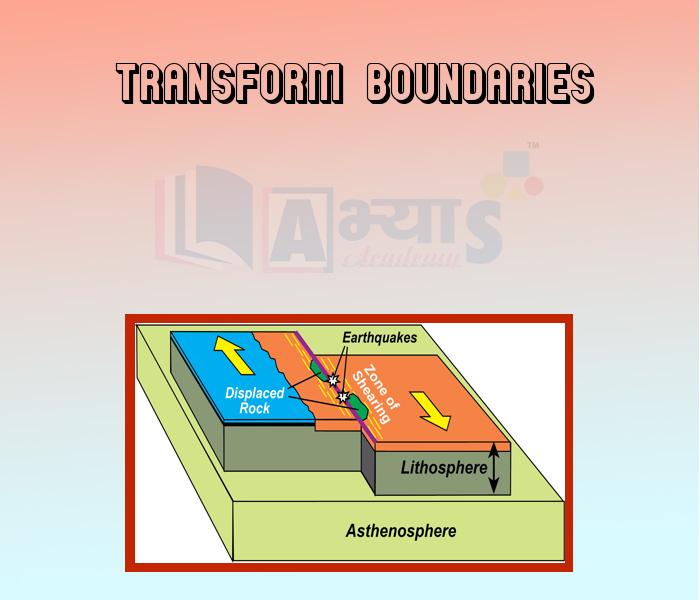Transform Boundaries

Transform Boundaries
Transform Boundaries : - A transform boundary is where two plates are sliding parallel to each other but in opposite directions relative to one another. The plates usually move very slowly past each other but then suddenly slip quickly. When this happens, there is an earthquake. Whether on land or under the ocean, a transform boundary usually has fold mountains along its length. There are also many cracks in the rock, and called fault lines. Fault lines usually do not form one continuous crack in the crust along the plate boundary. Instead there are many cracks parallel to each other. Transform boundaries are not constructive or destructive boundaries because they do not make new crust or destroy crust. They can destroy buildings and can buckle crust. They can destroy no rock is destroyed and none is created.
The San Andreas Fault in California (USA) is a transform boundary.
The is where the Pacific Plate and the North American Plate move past each other. The cities of Los Angeles and San Francisco are built near the fault line. This fault has moved in the past and has caused massive of San Francisco was destroyed.
Another transform fault runs right through New Zealand. Meeting at this fault are the Australian Plate (moving north-east) and the Pacific Plate (moving south-west). Movement of this transform boundary created the mountains of the South Island of New Zealand.

Alpine fault is formed by the movement of which two plates ? | |||
| Right Option : D | |||
| View Explanation | |||
Which of the following boundary movement is neither constructive nor destructive boundaries ? | |||
| Right Option : A | |||
| View Explanation | |||
Fault lines are formed during which type of boundary movement ? | |||
| Right Option : A | |||
| View Explanation | |||
Students / Parents Reviews [10]
It was a good experience with Abhyas Academy. I even faced problems in starting but slowly and steadily overcomed. Especially reasoning classes helped me a lot.

Cheshta
10thAbhyas Methodology is very good. It is based on according to student and each child manages accordingly to its properly. Methodology has improved the abilities of students to shine them in future.

Manish Kumar
10thMy experience with Abhyas is very good. I have learnt many things here like vedic maths and reasoning also. Teachers here first take our doubts and then there are assignments to verify our weak points.

Shivam Rana
7thMy experience was very good with Abhyas academy. I am studying here from 6th class and I am satisfied by its results in my life. I improved a lot here ahead of school syllabus.

Ayan Ghosh
8thA marvelous experience with Abhyas. I am glad to share that my ward has achieved more than enough at the Ambala ABHYAS centre. Years have passed on and more and more he has gained. May the centre flourish and develop day by day by the grace of God.

Archit Segal
7thBeing a parent, I saw my daughter improvement in her studies by seeing a good result in all day to day compititive exam TMO, NSO, IEO etc and as well as studies. I have got a fruitful result from my daughter.

Prisha Gupta
8thIt was good as the experience because as we had come here we had been improved in a such envirnment created here.Extra is taught which is beneficial for future.

Eshan Arora
8thAbhyas is a complete education Institute. Here extreme care is taken by teacher with the help of regular exam. Extra classes also conducted by the institute, if the student is weak.

Om Umang
10thI have spent a wonderful time in Abhyas academy. It has made my reasoning more apt, English more stronger and Maths an interesting subject for me. It has given me a habbit of self studying

Yatharthi Sharma
10thMy experience with Abhyas academy is very good. I did not think that my every subject coming here will be so strong. The main thing is that the online tests had made me learn here more things.




